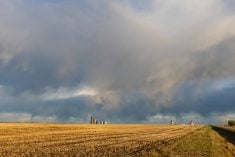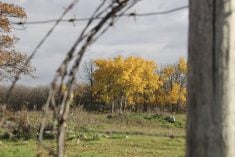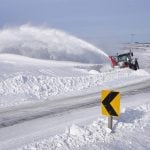As we ease into what can be the stormiest and snowiest time of the year on the Prairies, the big question is—are we going to see a late winter snowstorm? Well, I can say that we won’t. What I can say is the odds are low in this forecast period.
Late February and early March’s shot of spring weather, the atmospheric flow across the Prairies looks to be westerly to slightly northwesterly. This will keep the main storm track to our south while the northerly storm track is forecasted to remain weak.
Read Also

Prairie forecast: Warm start, then cooler
Prairie forecast calls for warm temperatures to give way to cooler, wetter weather week of Oct. 22-29.
We start off with a broad but weak area of high pressure covering most of the southern and central Prairies. Over northern regions, a weak disturbance over northern Saskatchewan is forecasted to push southeastwards in the northwesterly flow. For the weekend, the weather models show some weak ridging building over B.C. and Alberta. This should bring some nice warm air to that region.
Further east, warm air will be trying to push east from the western ridge but will be fighting against a broad trough of low pressure over northeastern Canada. Along this zone, a couple of weak areas of low pressure are forecasted to slide southeastwards as they move in off the Pacific and ride over the western ridge. Early next week the flow looks to become zonal or westerly, which will bring quiet weather and average temperatures across the Prairies.
Alberta
This region will start with weak high pressure in place, giving sunny to partly cloudy skies and temperatures on either side of average. Expect daytime highs over southern and central regions to be in the 2 to 5 C range with overnight lows falling to around -5 to -8 C. In the Peace River regions, expect temperatures to be a few degrees cooler.
On Friday the region will begin to feel the effects of a building ridge of high pressure. This ridge will slowly push northwards over the weekend, which will bring a continuation of sunny skies along with milder temperatures. Daytime highs over southern regions are forecasted to be in the 10 to 15 C range. Even warmer readings are possible over extreme southern areas. Overnight lows look to remain around the freezing mark. Over central and northern regions, daytime highs are forecasted to be in the 5 to 10 C range with overnight lows falling to around -4 C.
Late on Sunday, an area of low pressure is forecasted to move in off the Pacific and move into central Alberta before sliding off to the southeast on Tuesday. This will bring clouds and the chance of some showers or flurries early on Monday. The low will flatten the upper ridge and bring a return to more seasonable temperatures to end this forecast period.
Saskatchewan and Manitoba
This forecast period starts with a broad ridge of high pressure bringing sunny to partly cloudy skies and near average temperatures. By Saturday, a building upper ridge of high pressure over Alberta and B.C. will begin to push milder air eastwards.
Saskatchewan, especially southwestern regions, will see the warmup begin on Friday. Daytime highs over the weekend in that region are expected to be in the 10 to 15 C range. Over the rest of southern and central Saskatchewan, expect highs to start off around -3 C on Wednesday and slowly warm towards the 6 to 9 C mark by Sunday.
Across Manitoba the warm-up will be delayed. Milder temperatures aren’t forecasted to move in until Saturday. There’s a chance of some clouds and flurries on Friday and Saturday morning across central Saskatchewan and southern Manitoba as a weak low slides southward.
The next chance for snow will come from an area of low pressure that’s forecasted to move out of central Alberta late on Sunday. It will track across central Saskatchewan and Manitoba on Monday. Currently it looks like any precipitation from this system will fall from central Saskatchewan southeastwards into the Interlake region of Manitoba.
Confidence in the track of this system is low, but current indications are that some areas may see a quick 2 to 5 cm of snow as the system moves through. Areas to the south will see one more mild day on Monday before colder air moves in behind the low on Tuesday. Expect temperatures to drop to more seasonable values with daytime highs in the -2 C range with overnight lows falling to around -10 C.
— Daniel Bezte is a teacher by profession with a B.A. (Hon.) in geography, specializing in climatology from the University of Winnipeg. He operates a computerized weather station near Birds Hill Park, Man. Contact him via email with your questions and comments.















